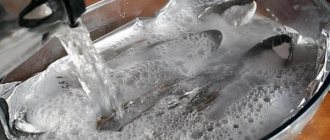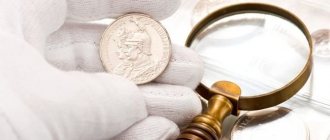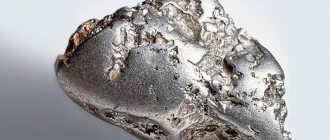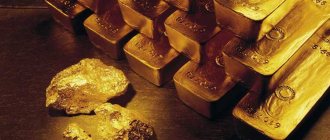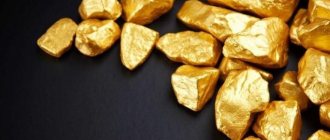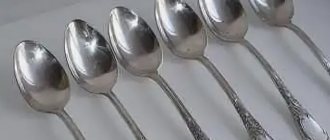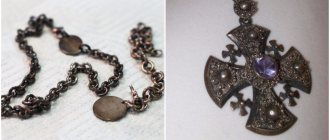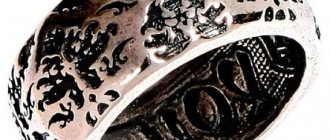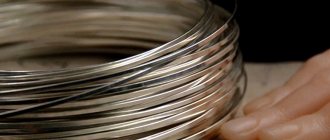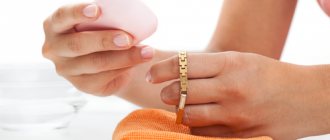March 3, 2022 Determining the authenticity of silver in today's realities is not such a meaningless procedure. Despite its apparent cheapness, the noble metal is counterfeited no less often than gold - low-grade alloys, or even stainless steel or tin, are sold under its guise. Most often, this is a “disease” of exotic oriental markets and flea markets, where deception of the buyer is common, but sometimes this occurs even in jewelry boutiques.
In this material, we will tell you in as much detail as possible how to distinguish real silver from a fake, without resorting to expensive laboratory examinations.
Silver and silver plating: how to distinguish
There are several signs that can be used to identify a fake with a high degree of accuracy. True, the basis is simple logic. Criteria to distinguish Ag from silver-plated jewelry:
- the presence of a stamp: on a fake coated with precious metal there will be no test, since too little Ag is used, but even if the stamp is still applied, its quality and shape are assessed, for example, sloppy embossing, incorrect contour geometry - these are signs handicraft production;
- quality of the coating: if the product has already been in use, damage remains on it (scratches, cracks, chips, etc.), a fake can be immediately distinguished - another metal will be visible under the coating, silver has a characteristic color - gray-white;
- rusting: Ag in combination with a ligature (as part of an alloy) is not subject to corrosion, while steel or other base metal may become covered with red spots, this indicates that a fake is being considered.
Features of silver products
When choosing silver products, you must definitely consider it. The product must have two marks: from the manufacturer and according to the GOST standard. A sample is also required. Silver samples: 800, 830, 875, 925, 960, 999.
If there is no stamp on a product you like, this is not a reason to panic; most likely the standard is too low (below 800 - a stamp is not placed on the product) or the original jewelry was not made for sale.
Each product must have a manufacturer's tag, which indicates the name and legal address of the manufacturer, size, sample and name of the precious metal, as well as the cost of the product, weight in grams and price per 1 gram. The tag should be made of thick paper, wrapped in film.
Differences of silver:
- in its pure form it wrinkles easily;
- the surface is smooth and shiny;
- characteristic grayish color;
- the metal is highly susceptible to corrosion.
TOP 3 ways to determine technical silver without leaving home
Technical metal is called metal without additives. The maximum proportion of impurities is regulated - 0.01%. This type of silver is used to coat contacts and radio components during soldering. The main area of application is various industries.
Technical silver plates
Checking silver coins
A special approach is required to assess the quality of a coin. To test it, prepare a neodymium magnet. A souvenir from the refrigerator door will not work because it requires a powerful source of magnetic field. Its size must be at least 4x10 cm. The magnet is installed at an angle of 45°; for the purity of the experiment, it is necessary to check the accuracy of its location. It is known that Ag is not magnetic, but the presence of additives can be determined. A powerful magnet is used for this. When different types of materials are applied, different results are obtained:
- the product does not fall, which means it contains steel;
- slowly slides down - contains a significant proportion of copper;
- falls more rapidly, is weakly magnetic - contains nickel.
Silver coins
Checking old silver items
In earlier times, additives were practically not used or their quantities were less than today. Testing began relatively recently - several centuries ago, but the history of the use of precious metals goes back thousands of years. Given these features, only a jeweler can check whether an item is silver using the hydrostatic weighing method. The owner can use available means, but he is unlikely to be able to determine the quality of the precious metal.
How to tell if a tablespoon is silver or not
It is necessary to study the external signs of the object. A sample is placed on precious metals, but also on cutlery that is made from simple materials, the following markings are also found:
- cupronickel – MN (MELCH);
- aluminum - AL;
- stainless steel – STAINLESS;
- nickel silver – MNC.
Home methods are also used. They are relevant if there are no identifying marks on the product, but there are suspicions that the item is precious. When choosing a way to understand that a spoon is silver, one of the most effective is the method based on the use of ice. To test the precious metal, a piece is placed on a cutlery. If it melts quickly, it means the item is silver and valuable (Ag has the highest thermal conductivity).
Silver tablespoons
Checking silver for authenticity in a store
There are several effective ways to conduct a rapid test right next to the counter; they will not take much time and will not in any way affect the presentation of the product:
- Carefully inspect the inner surface of the jewelry - 925 standard is indicated there, and the numbers are always easy to read without magnifying glasses. Jewelry silver in the budget segment may have an 800 standard, but in Russia and the post-Soviet space, 92.5% of the pure metal content is accepted as the standard.
- In addition to the sample, large jewelry houses always apply the author's mark - this can be the name of the manufacturer, the corporate logo of the brand, an encrypted batch code with the year of production, or even the initials of a famous jeweler, if we are talking about an exclusive designer product.
- For jewelry inlaid with precious and semi-precious stones, be sure to look at the embossing of the insert fastening. The cast should be symmetrical and extend from the base without visible “welded” seams and, even more so, traces of glue. If there is something similar, most likely you are looking at aluminum or skillfully crafted tin.
- Without additional rhodium treatment, silver can look rather unattractive - lumpy areas, or vice versa - dimples, uneven color and a completely matte surface. The secret is that genuine items look exactly like this, and the absence of excessive gloss will only prove the highest quality.
- Noble metal oxidizes over time, darkens, becomes covered with a specific coating, but never rusts. If characteristic corrosion “stains” appear on the jewelry, then they are trying to sell you only iron plated with a thin layer, or another alloy that is vulnerable to rust.
- The high thermal conductivity of silver is one of its main physical properties, so don’t be afraid to ask to hold the jewelry in your closed palm for 10-15 seconds. Pure 925 sample will instantly absorb part of the temperature of the human body and will remain warm for at least several minutes.
- Finally, the most popular instant method for determining the presence of impurities in an alloy is to go to the store with a small magnet. Real silver is never attracted, the main thing is that the magnetized piece “works” as it should.
Using other traditional methods, it is recommended to check silver jewelry for authenticity after purchase, because some of them, if the rules are not followed, can seriously damage the surface, disrupting the attractive appearance.
Metals – counterfeit silver
There are materials whose products are similar to silver. External examination does not provide the desired result. To identify a fake and check the quality of the material, pay attention to a number of features.
Aluminum
Not knowing how to distinguish silver from other metals, they study external signs:
- the fake aluminum chain links are not soldered;
- The fake is made using glue for inserts, and not the standard method of fastening - claws.
Jewelers claim that the glue is used by scammers or manufacturers who do not respect their customers.
Tin
The main way to recognize a fake jewelry is to compare the color of the fake and real jewelry; tin is characterized by a uniform gray tint; Ag is similar in tone, but you can additionally see dark spots on its surface. By the way, sulfur and compounds that contain it contribute to their appearance. Tin behaves differently in relation to this component - it forms a substance reminiscent of gold.
Iodine
A drop of iodine and the product being tested are required. Iodine reacts chemically with silver. The process is accompanied by darkening at the point of contact between iodine and silver. The mark from a reaction to iodine is very difficult to remove, so the method is not very good. It is better to conduct the experiment on the inside of the object.
Reaction of silver to iodine.
- A drop of iodine on real silver will leave a dark stain.
- Iodine does not react with other metals. The surface where iodine was applied will remain unchanged.
Iodine stains are difficult to remove! Be careful, check from the inside of the products.
At home, it is not possible to determine the sample and silver-plated products. Aluminum and copper blanks coated with a thin layer of silver are often found. Iodine will leave a mark on such products, but the silver content cannot be determined in this way.
Testing with iodine is one of the effective methods for identifying fake silver at home. The remaining methods are more suitable for self-soothing or are less accessible for self-checking.
Method for determining a sample at home
There are not always special devices or substances at hand. But some reagents are still available to the public, and not just to laboratory workers.
What is Chrompeak
Chrompic is a chemical often used by jewelers to evaluate the quality of an alloy. Prepared:
- gloves;
- pipette;
- sewing needle;
- tweezers.
Instructions that allow you to quickly recognize a fake or, conversely, verify the authenticity of an item:
- Notches are made on the product using a nail file.
- Chrompik is applied.
- Observe the reaction. If there is Ag in the material, the object will turn red. Other shades indicate counterfeit jewelry or the use of another precious metal.
Chrome pick for silver
Table: sample and color ratio
When using a homemade reagent, changes can be seen within 5-10 minutes. If you are wondering how to recognize silver, the relationship between the combination of alloy and the color of the alloy will help you figure it out:
| Hue | Metal |
| Rich brown | Brass |
| Yellow | Sn, Pb |
| Bluish | Ni |
| Green | Ag alloy fineness less than 800 |
| Brown | Metal 800 |
| Rich red | Popular sample 925 |
| Bright red | Pure Ag |
Sulfur ointment, nitric acid, whiteness
The principle of testing is the same as when testing with iodine. We apply a drop of the reagent to the product, wait and see if the product reacts to the drugs:
- A real silver item will show tarnish where the substances were applied.
- Nothing will happen on a fake.
Reaction to chemical exposure.
Question-answer section
How can you tell if it is silver or not if the metal is too dark?
Expert opinion
Pribrezhny Gennady Valentinovich
Jeweler 6th category
It happens that Ag also darkens, which occurs under the influence of external factors. Then authenticity can only be determined using third-party substances. Apply iodine or nitric acid. In both cases, the real precious metal will darken even more.
Is silver magnetic or not?
Expert opinion
Andrey Seleznev
Chemist-technologist, Volgograd
Ag without additives does not exhibit magnetic properties and does not create a magnetic field. The precious metal will not react to the use of a magnet. Silver-based alloys behave differently. The larger the ligature, the more strongly the jewelry or other object is attracted.
How to check whether silver bought at a pawn shop is real if there is no hallmark?
Expert opinion
Grishanov Mikhail Petrovich
Jeweler, director of the Grishanov and Co. workshop
The absence of a sample is not always a sign of a fake. If the item has a characteristic color (white-gray with darkening), is quite heavy, and also reacts to acids with the appearance of black spots, there is a possibility that the item is precious. A jeweler can say more precisely.
Determine the purity of silver
Pure silver of the highest standard (999) is not used for jewelry and cutlery. This is because it is too soft, plastic and wrinkles easily. This kind of silver is called technical silver. Used in industry, for silver plating, as well as for casting silver ingots.
How can we determine that this is pure silver? Chalk and boiling water will help identify the 999 sample.
You need to rub the silver hard with chalk; if black stripes appear on the chalk, the silver is pure technical silver.
Due to its good thermal and electrical conductivity, silver will instantly heat up in hot water, just put it in a glass of boiling water.
You can also rub the silver with sandpaper: under the erased top layer it will be immediately visible whether there is silver inside or another metal.
Characteristics and properties of metal
Silver (Ag) is the 47th element of the Mendeleev Periodic Table. Melting point – plus 962 oC, density – 10.5 g/cm3. Electrical resistivity – 1.59⋅10−8 Ohm m at a temperature of 20 °C.
The noble metal in its pure form reacts weakly with other substances. It is insoluble in hydrochloric and dilute sulfuric acid, soluble in mercury and ferric chloride.
Silver does not oxidize under the influence of oxygen, but when exposed to air over time it can lose its luster and darken. The fact is that it reacts with hydrogen sulfide molecules present in small quantities in the atmosphere. As a result, silver sulfide is formed. Its coating gives darkening. This is especially noticeable in conditions of high humidity.
2Ag + 2H2S + O2 = 2Ag2S + 2H2O
Halogens easily oxidize Ag to halides. Many methods for determining the authenticity of silver products are based on this.
Important: carry out all studies based on the chemical interaction of metal on a cleaned surface. Choose an inconspicuous area.
Sample and touchstone
Modern rules that form the basis for the circulation of precious metals make it possible to distinguish copper and other additives from silver, as well as determine their content in a product. For this purpose, a measure has been established, the so-called test. And to monitor compliance with the rules, special devices have been invented.
You need to know about the sample system and the rules for their use:
- The sample shows how much Ag is contained in the alloy. It represents a three-digit number. Conventionally, each unit here means 1 gram in 1 kilogram. But kilogram jewelry is a thing of the past. Therefore, the measuring unit on modern products simply shows every tenth of a percent of argentum.
- When making jewelry, 925 alloys are most often used. This means that they contain 92.5% Ag and 7.5% copper.
- Less common hallmarks: 750, 800, 875, 916, 960. 999 alloy (almost pure precious metal) is used only for specialty bars, high-value collectible coins and in some high-precision fields of science.
- If a product claims to be called silver, the purity must be indicated on it. It is applied by branding. Information about it is also indicated on the attached product label. The label fastening must be sealed. If the seller does not comply with these mandatory, legally established conditions, there is a high chance of encountering a counterfeit.
- In addition to the sample, the label must contain other information about the decoration. This is its name, weight, total price and price per 1 gram, name of the manufacturer, description of the stones (if any). If the product is plated (for example, rhodium), this must also be indicated.
- Information about the name, weight, sample, and price of the product must also be included in the purchase receipt.
- You can test the product for samples and additives using a touchstone. To do this, you will need to make a scratch on the jewelry and drip the reagent. Brown color, for example, will indicate the presence of brass. The yellow color will help distinguish silver from tin (lead will also signal its presence with yellow).
You can purchase the stone at a jewelry store. It should come along with a plate from which, depending on the reaction of the alloy, its composition can be accurately calculated. Now good stones are offered at prices ranging from 700-800 rubles.
Russia, of course, is not Latin America, whose countries are world leaders in argentum production. But there is also enough silver in the state. Citizens do not encounter counterfeits very often. To avoid them, as a rule, it is enough to purchase jewelry in specialized stores , and not at market stalls or station stalls.
Source
Modern home laboratory
In modern conditions, you can distinguish silver from a fake at home. The achievements of physics, young chemist kits, and medications are now available to people. You just need to know how to apply this or that method.
Simple and fast
A method that has been passed down from century to century is to scratch the inside of the ring with a needle. When this succeeds too easily, and a different shade is discovered under the top layer, there is a fake with spraying. But now scammers know how to make fakes that will pass such a primitive test.
There are more reliable home methods:
- Vinegar. Scratch the ring rim. Drip vinegar (away from stones). If green foam appears, then the product is most likely fake.
- Lapis. It contains Ag ions. You need to work with gloves. Rub the lapis on the jewelry and observe the reaction. A normal fusion will demonstrate its absence. The fake will turn black.
- Sulfuric ointment. Apply it to the product and leave for 2-3 hours. Then wipe the jewelry and rinse it. Argentum will become dark. A fake, depending on the metals used, will either not react or will give a yellow, pink or greenish tint.
- Iodine. You will need a white plate. Place the product on it. Drop iodine. If there is no reaction, the argentum is not real (perhaps nickel silver was purchased under its guise). A blue spot appeared - a lot of zinc. Blackness defines quality jewelry.
- Chalk (regular white will do). The ring or chain needs to be rubbed vigorously. If the jewelry turns black, it contains enough Ag.
- Magnet. Silver will not be magnetized. But this is not a very reliable method - some metals will react the same way. But this method can be effective when the links of the chain are made of different alloys. Part of the decoration will be attracted, and part of it will not.
- Ice. Place a piece of it on a piece of jewelry that has been stored at room temperature or just removed from your hand. If the ice begins to melt immediately, this is a good indicator.
Some of these methods are dangerous because they can damage both the product and the utensils used. But cleaning the jewelry itself can become an additional test. Argentum can be made to shine with moonlight again by rubbing with ammonia or raw potatoes. Zinc alloy will no longer give the same shine.
In the footsteps of Mendeleev
True chemistry buffs can put their passion to work to their advantage in determining the authenticity of jewelry. Impurities in lunar metal will make it possible to identify various acids and their mixtures. In some cases, it will be possible not only to verify the presence of additives, but also to classify them.
Observing safety precautions, you can conduct the following experiments:
- With nitric acid. The product will have to be scratched. Acid should be dripped onto the damaged area. A strong green coating will indicate excess copper. Sample 925 and higher will give a beige tint. Very pure Ag will turn black.
- With potassium dichromate. It is used in photography and pyrotechnics. Clean the product, wipe with alcohol, and dry. At intervals of a few seconds, drop the solution onto it two or three times. Immediately remove excess with a napkin. A sample of 750 or more will react in red. The more argentum there is in the alloy, the redder the spot will be.
- With gold chloride. It is prepared using a mixture of hydrochloric and nitric acid (aqua regia). Clean the product. Apply the reagent to it. The result appears immediately. If the sediment is inky, a quality product is being tested. Yellow and brown colors indicate the presence of aluminum and excess copper.
- With silver nitrate. The light gray color of this reagent on the product will indicate a high sample (from 750). Cloudy white is the opposite.
You need to understand that jewelry can be damaged by using acids. Counterfeits can become completely unusable. Since zinc and tin corrode quickly, the chain may simply break.
Most tests do not provide complete confidence in the accuracy of the assessment made. You also need experience. But all of them at least partially allow us to understand what kind of product a person is dealing with.
Thermal method
One of the properties of silver is thermal conductivity, due to which the metal quickly heats up to ambient temperature. If you hold the product in your hand, it will almost immediately heat up to body temperature. When immersed in cold or hot water, the metal will quickly return to the same temperature.
Boiling water is a good way to test the quality of a silver alloy. When removed from a hot product, it burns the skin and quickly cools to room temperature. Fake silver removed from boiling water will be lukewarm.
